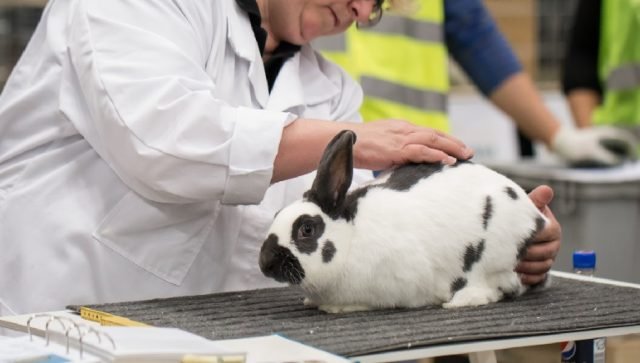Learn everything you need to know about rabbit care basics in this comprehensive guide for beginners. From housing to diet and healthcare, we’ve got you covered!
Table of Contents
Introduction to Rabbit Care Basics
Rabbits are adorable, gentle, and intelligent creatures that make wonderful pets. However, they require specific care to ensure they are happy and healthy. This comprehensive guide covers all the basics of rabbit care, from understanding their behavior to choosing the right breed, setting up housing, providing proper nutrition, and maintaining their health. By following these guidelines, you can provide the best possible environment for your furry friend.

Understanding Rabbit Behavior
Rabbits are social animals with unique behaviors that can be both endearing and puzzling to new owners. Understanding these behaviors is crucial for building a strong bond with your pet and ensuring their well-being.
Common Rabbit Behaviors
- Thumping: When a rabbit feels threatened or senses danger, it will thump its hind legs as a warning signal.
- Binkying: This joyful leap and twist in the air indicate that your rabbit is happy and playful.
- Chinning: Rabbits have scent glands under their chins, and they rub their chins on objects to mark their territory.
- Digging: This natural behavior can be redirected by providing a digging box filled with safe materials like shredded paper.
- Chewing: Rabbits need to chew to keep their teeth healthy. Provide chew toys and safe branches to satisfy this instinct.
Choosing the Right Rabbit Breed
Rabbits come in various breeds, each with its characteristics and care requirements. Some popular breeds for beginners include:
- Mini Rex: Known for their velvety fur and friendly nature.
- Holland Lop: Cute little dog with floppy ears.
- Lionhead: Recognizable by their woolly manes, they are gentle and easy to handle.
- Netherland Dwarf: Tiny and energetic, they require careful handling.
Consider factors such as size, temperament, and grooming needs when choosing a breed. Researching the specific needs of each breed will help you make an informed decision.
Setting Up Rabbit Housing
Proper housing is essential for your rabbit’s safety and comfort. Rabbits can be kept indoors or outdoors, but indoor housing is generally safer and more secure.
Indoor Housing
- Cage or Hutch: Provide a spacious cage or hutch with a solid floor. Wire floors can hurt their feet.
- Bedding: Use soft, absorbent bedding like paper-based litter or hay.
- Hideaway: Include a hideaway where your rabbit can retreat for privacy and security.
- Exercise Space: Allow your rabbit ample space to exercise outside of their cage daily.
Outdoor Housing
- Hutch: Ensure the hutch is weatherproof, predator-proof, and well-ventilated.
- Run: Provide a secure run for outdoor exercise and exploration.
- Location: Place the hutch in a shaded, sheltered area to protect your rabbit from extreme weather conditions.
Essential Rabbit Diet and Nutrition
For optimal health, your rabbit requires a balanced diet. Water, hay, pellets, and fresh veggies should be their only foods.
What to Feed Your Rabbit

- Hay: The main component of a rabbit’s diet, hay promotes oral health and digestion. Every day, provide an infinite supply of new hay.
- Vegetables: Provide a variety of fresh vegetables, including leafy greens, carrots, and bell peppers.
- Pellets: High-quality rabbit pellets should be given in moderation, as they are rich in nutrients but can cause obesity if overfed.
- Water: Always have a bowl or bottle of clean, fresh water available.
Feeding Schedule and Portions
- Hay: Unlimited supply available at all times.
- Vegetables: About one cup per 2 pounds of body weight daily.
- For every five pounds of body weight, consume one-half cup of pellets daily.
- Treats: Offer occasional treats like fruits or commercial rabbit treats, but avoid sugary or high-calorie options.
Rabbit Healthcare Basics
Regular healthcare is essential to prevent and manage common health issues in rabbits.
Common Health Issues in Rabbits
- Dental issues: Pain and difficulty eating might result from overgrown teeth.
- Gastrointestinal Stasis: This serious condition involves a slowdown of the digestive system. Ensure a high-fibre diet and plenty of exercise to prevent it.
- Labored breathing, runny nose, and sneezing are signs of respiratory infections. If you experience these symptoms, visit a veterinarian.
- Parasites: Regularly check for fleas, mites, and worms, and use appropriate treatments as needed.
Grooming and Hygiene Practices
- Brushing: Consistent brushing minimizes shedding and helps avoid matting.
- Nail Trimming: Trim your rabbit’s nails regularly to prevent overgrowth and injury.
- Ear Cleaning: Check your rabbit’s ears for signs of infection or wax buildup and clean them gently with a damp cloth if necessary.
- Litter Training: Rabbits can be litter trained. Provide a litter box with rabbit-safe litter in their living area.
Conclusion
A rabbit needs knowledge, commitment, and love to properly care for it. By understanding their behavior, choosing the right breed, providing appropriate housing and nutrition, and ensuring regular healthcare, you can create a happy and healthy environment for your rabbit. This guide serves as a comprehensive resource for beginners, helping you embark on a rewarding journey with your new furry friend. Remember, the more you learn about your rabbit’s needs and behaviors, the better equipped you’ll be to provide the best care possible. Enjoy the delightful companionship of your rabbit and the joy they bring into your life.
More Gude: Useful Tips for your beloved pets











